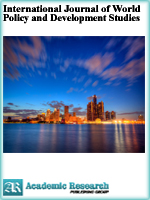International Journal of World Policy and Development Studies
Online ISSN: 2415-2331
Print ISSN: 2415-5241
Print ISSN: 2415-5241
Quarterly Published (4 Issues Per Year)

Archives
Volume 5 Number 6 June 2019
Quality Assurance of Available Portland Cements in Nigeria
Authors: Catherine Mayowa Ikumapayi ; Fakorede Ebenezer Oluwabusuyi
Pages: 53-63
DOI: doi.org/10.32861/ijwpds.56.53.63
Abstract
The notable demand for the want of cement in our time has stimulated increment in cement production and increment in manufacturers to be had in our day. These in turn amongst others have brought about failure of buildings and other construction members. As a result, the need to ensure the quality of available cement in circulation is of utmost paramount. This research work studies the available Portland lime cement of grade 42.5 only, in Nigeria from such company as company A, company B, and company C. The qualities and properties of the Portland lime cement from every of the above-named companies were investigated and as compared. Properties like Fineness, Setting Time, Chemical composition, Specific gravity, Consistency, Loss of ignition, Strength (compressive strength, and flexural strength), Micro structural analysis were determined according to relevant BS EN 197-1 (2011) and (ASTMC) 150-92 standards. These tests were carried out with the usage of scanning electron microscope, X-ray fluorescence spectrometer, Vicat apparatus, compressive strength machine, consistency apparatus and Chatelier flask, among others. The results showed that the chemical composition mostly of CaO, SiO2, AL2O3 and MgO in the cement +are within the acceptable limit of 60.0-67.0, 17.0-25.0, 3.0-8.0 and 0.1-4.0 respectively in the BS 4550: Part 3 (1979). The results of the compressive strength acquired for all the cement have been a way beneath the standardized result expected for grade 42.5. These could partly be traced to the cement micro-structure as Company C with the best morphology exhibits better compressive strength than others. Improvement on the cement morphology by the manufacturers could lead to compressive strength improvement. It was also discovered that one of the important factors that would have contributed to the low compressive strength was excessive amount of silt/clay content material inside the sand used.



